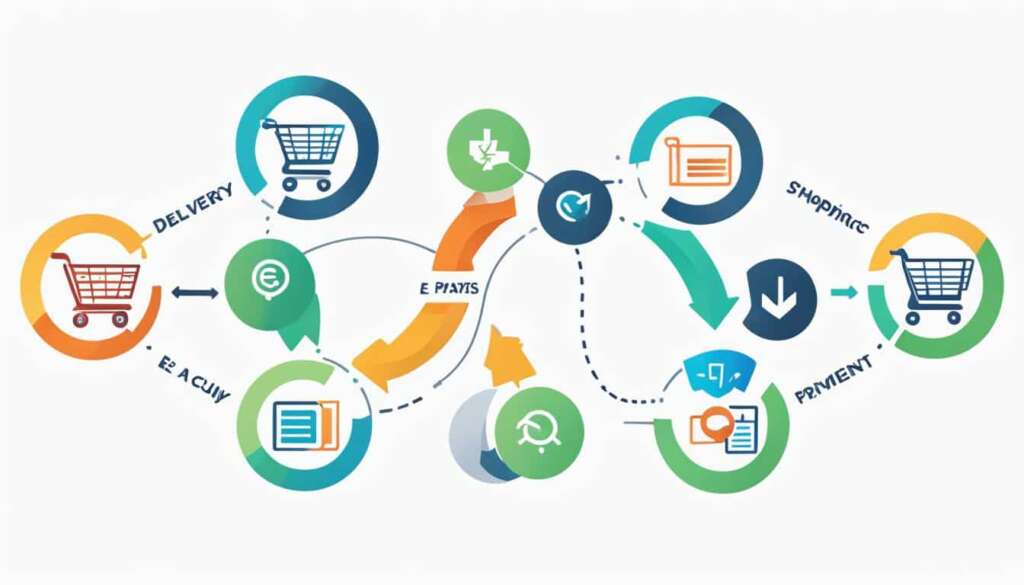Table of Contents
The digital marketplace has revolutionized the retail industry, creating a world of opportunities for businesses to reach a global audience. However, with these opportunities come unique challenges that retailers must navigate to stay ahead in the competitive e-commerce landscape.
According to recent statistics, global e-commerce sales are projected to reach a staggering US$7.4 trillion by 2025, highlighting the immense potential of the digital marketplace. As the number of digital buyers continues to rise, retailers must adapt to the changing consumer landscape and address the challenges posed by e-commerce.
One of the main challenges retailers face is understanding customer behavior and preferences. In today’s digital age, consumers expect personalized experiences tailored to their shopping histories and preferences. However, many retailers struggle to gather and analyze the data needed to meet these expectations.
Another challenge is ensuring consistency in marketing efforts. In an omnichannel retail environment, it is crucial for retailers to have a cohesive and personalized marketing strategy. Unfortunately, many marketers find it challenging to deliver consistent and personalized marketing messages, resulting in wasted marketing spend.
The recent deprecation of third-party cookies further adds to the challenges faced by retailers. With browsers disabling third-party cookies by default, tracking customer data and delivering personalized experiences becomes more difficult. Retailers must find alternative ways to understand the customer journey and deliver tailored experiences without relying on traditional tracking methods.
Adopting the right technology is also a significant challenge for retailers. While some may be hesitant to disrupt their established workflows, embracing innovative technologies and partnerships can lead to improved customer engagement and market dominance.
Finally, security and privacy are critical concerns for retailers operating in the digital marketplace. With cyber-attacks and data breaches becoming increasingly common, retailers must prioritize the protection of customer data and gain their trust.
By acknowledging and addressing these e-commerce challenges, retailers can position themselves for success in the digital marketplace. It is essential for retailers to invest in data-driven insights, consistent marketing strategies, innovative technology, and robust security measures. By doing so, they can navigate the e-commerce landscape and thrive in the evolving retail industry.
Challenge #1 – Lack of Understanding Customer Behaviour and Preferences
Modern consumers expect a tailored customer experience that considers their shopping histories and preferences. However, many retailers lack usable data insights to meet this demand. Data-driven organizations are 23 times more likely to acquire customers, six times more likely to retain customers, and 19 times more likely to be profitable.[1]
Retailers face hurdles in updating their CX strategy, including difficulty linking business outcomes to customer needs and insufficient technology platforms. They need a platform that visualizes data and allows immediate action on insights.
“To truly understand and meet customer expectations, retailers must embrace data-driven insights that provide valuable information about customer behaviour and preferences. By translating this data into meaningful actions, retailers can elevate their customer experience and gain a competitive advantage in the digital marketplace.”
Importance of Data-Driven Insights
- Data-driven insights enable retailers to:
| Benefit | Explanation |
|---|---|
| Acquire Customers | Data-driven organizations are 23 times more likely to acquire customers, leveraging insights to attract and engage potential buyers. |
| Retain Customers | By understanding customer behaviour and preferences, retailers can personalize their offerings, resulting in higher customer loyalty and retention. |
| Drive Profitability | Data-driven organizations are 19 times more likely to be profitable, as insights inform more effective business decisions and optimize customer acquisition and retention strategies. |
The benefits of data-driven insights clearly demonstrate the importance of overcoming the challenge of lack of understanding customer behavior and preferences. By investing in technology platforms that enable accurate data visualization and actionable insights, retailers can enhance their CX strategy and deliver exceptional customer experiences.
Challenge #2 – Sporadic Marketing
In the omnichannel retail environment, a consistent marketing approach is essential. It ensures that your brand message is cohesive across all touchpoints with your customers. However, many marketers struggle with personalization and mapping the customer journey, making it challenging to create a consistent and personalized marketing strategy.
Without personalization, you are essentially taking a “scattershot” approach to marketing, wasting valuable resources and missing out on opportunities to connect with your target audience. This leads to wasted marketing spend and suboptimal results for your campaigns.
According to a recent survey, 37% of marketers report wasted marketing spend, resulting in an estimated average annual loss of US$1.2 to 16.5 million for midsize and enterprise companies. This staggering figure highlights the urgent need for improved marketing strategies that focus on personalization and consistency.
To overcome this challenge, retailers should adopt analytical tools that offer insights analysis and behavior-based workflows. These tools can help you gather meaningful data about your customers and their preferences. By leveraging this data effectively, you can create more personalized marketing campaigns that resonate with your target audience.
| Percentage of Marketers Reporting Wasted Marketing Spend | Average Annual Loss (in US$) | |
|---|---|---|
| Midsize Companies | 37% | $1.2 million – $16.5 million |
| Enterprise Companies | 37% | $1.2 million – $16.5 million |
By investing in technologies that enable personalization and consistent marketing, you can optimize your marketing spend and achieve better results. These tools allow you to segment your audience effectively, deliver targeted messages, and tailor the entire customer journey to provide a seamless and personalized experience.
The Benefits of Consistent Marketing:
- Improved customer engagement and satisfaction
- Increased brand loyalty and repeat purchases
- Higher conversion rates and sales
- Optimized marketing spend and ROI
By addressing the challenge of sporadic marketing and embracing personalization, you can create a competitive edge in the digital marketplace and drive success for your retail business.

Challenge #3 – The Death of Third-Party Cookies
The deprecation of third-party cookies presents a significant challenge for marketers in the digital landscape. Browsers like Firefox, Safari, and Google Chrome have disabled third-party cookies by default, making it increasingly difficult to track the necessary data for effective marketing strategies.
Marketers are now facing the prospect of increased spending to reach the same targets in 2022. The demise of third-party cookies forces retailers to find alternative methods to understand the customer journey and deliver personalized experiences.
Consumer data privacy has become a pressing concern as users demand more control over their personal information. With the phasing out of third-party cookies, retailers must navigate the fine line between personalization and respecting user privacy.
To overcome this challenge, retailers need to adopt innovative solutions that enable them to understand the customer journey through first-party data and segmentation. By leveraging recommendation engines powered by machine learning, retailers can deliver hyper-personalized content and create user-centric experiences.
By capturing and analyzing user data directly, retailers can gain insights into customer preferences, behaviors, and purchase patterns. This enables them to provide targeted recommendations and tailored promotions, enhancing the overall customer experience.
In conclusion, the death of third-party cookies poses a significant challenge for marketers. However, by prioritizing consumer data privacy and embracing alternative methods for personalization, retailers can continue to provide personalized experiences and drive customer engagement in the evolving digital landscape.
Challenge #4 – Adopting the Wrong Technology
In the rapidly evolving landscape of e-commerce, many retailers find themselves hesitant to adopt new technologies. This reluctance stems from the fear of disrupting established workflows. However, what these retailers fail to realize is that by embracing the right technology, they can achieve better customer engagement, foster growth, and establish dominance in the market.
Choosing the right technology partner is of utmost importance. It ensures a smooth transition, avoiding unnecessary disruptions, and guarantees a commitment to the entire service life cycle. With the constant advancements in technology, integrating essential tools has become easier than ever before. Retailers have the option for codeless implementation, allowing for a seamless adoption process.
“The future belongs to those who embrace innovation and adapt to disruptive technologies.”
By being open to innovation and willing to adopt the right technology, retailers can position themselves at the forefront of the industry. This not only enables them to cater to evolving customer demands but also strengthens their competitive edge. The key lies in recognizing the potential of disruptive technologies and embracing them to drive business growth and success.
With this in mind, let’s explore some innovative technologies that retailers can consider adopting to overcome the challenges they face in the e-commerce landscape.
Technology 1: Artificial Intelligence (AI)
AI is revolutionizing e-commerce by enabling personalized recommendations, chatbots for customer support, and advanced data analytics. By leveraging AI-powered algorithms, retailers can gain valuable insights into customer preferences, enhance the shopping experience, and streamline business operations.
Technology 2: Augmented Reality (AR)
AR offers customers a virtual try-on experience, enhancing product visualization and reducing the chances of returns. Retailers can leverage AR technology to engage customers, boost sales, and provide an immersive shopping experience.
Technology 3: Internet of Things (IoT)
The IoT allows retailers to connect physical products to the digital world, enabling real-time inventory management, personalized marketing campaigns, and enhanced customer experiences. By adopting IoT solutions, retailers can optimize operations, deliver targeted promotions, and improve supply chain efficiency.
Adopting the right technology is essential for retailers to stay ahead of the curve and meet the ever-changing demands of the digital marketplace. By embracing innovation and disruption, retailers can unlock new opportunities, drive growth, and remain competitive in the e-commerce landscape.
Challenge #5 – Security and Privacy
Retail remains one of the most targeted sectors for cyber-attacks, with a 264% surge in ransomware attacks over the last 12 months. Data breaches and cyber-attacks pose significant threats to the security and privacy of retailers and their customers. These incidents not only result in financial losses but also lead to a loss of customer trust and a negative impact on the brand’s reputation.
Data breaches cost companies an average of $3.86 million and take an average of 280 days to contain. The implications of such breaches are far-reaching, affecting both the organization and its customers. Retailers must prioritize security and privacy measures to safeguard sensitive information and protect customer trust.
In order to mitigate the risk of cyber-attacks and data breaches, retailers must choose technology partners with robust security infrastructures. Implementing strong cybersecurity protocols and ensuring compliance with global privacy and security regulations are crucial steps towards protecting customer data and maintaining their trust.
An effective cybersecurity strategy includes:
- Regular vulnerability assessments and penetration testing
- Strict access controls and authentication measures
- Encryption of sensitive data
- Continuous monitoring and threat intelligence
- Employee training and awareness programs
By investing in robust security measures and partnering with reputable technology providers, retailers can minimize the risk of data breaches and cyber-attacks, thereby safeguarding customer trust and their own reputation.
| Year | Number of Data Breaches |
|---|---|
| 2019 | 1,473 |
| 2020 | 1,001 |
| 2021 | 1,108 |
Safeguarding Customer Trust
Customer trust is paramount in the retail industry. In the wake of high-profile data breaches and cyber-attacks, consumers are increasingly concerned about the security of their personal information. Building and maintaining customer trust requires retailers to prioritize the protection of customer data.
“Data breaches and cyber-attacks not only result in financial losses but also lead to a loss of customer trust and a negative impact on the brand’s reputation.”
Implementing robust security measures and adhering to privacy regulations demonstrate a retailer’s commitment to protecting customer information. By maintaining a strong security posture, retailers can instill confidence in their customers, assuring them that their data is safe and their privacy is respected.

Conclusion
Navigating e-commerce challenges is crucial for retailers to thrive in the rapidly growing retail market. By understanding customer behavior and preferences, implementing consistent marketing strategies, adapting to the changes brought by the death of third-party cookies, adopting the right technology, and prioritizing security and privacy, retailers can overcome these challenges and position themselves for success in the e-commerce landscape.
Firstly, gaining insight into customer behavior and preferences is essential for retailers to meet customer expectations. By leveraging data-driven insights, retailers can deliver a personalized customer experience that drives acquisition, retention, and profitability. Investing in technology platforms that visualize data and enable immediate action on insights is key in this endeavor.
Secondly, implementing consistent marketing strategies across channels is vital for retailers to maximize their marketing spend and deliver targeted messaging. By utilizing analytical tools that provide insights analysis and behavior-based workflows, retailers can ensure a more precise and effective marketing approach. This reduces wasted marketing spend and increases promotional ROI.
Additionally, retailers must navigate the challenges presented by the death of third-party cookies. By understanding the customer journey, segmenting users, and delivering personalized experiences, retailers can still provide hyper-relevant content and maintain customer engagement. Recommendation engines powered by machine learning can play a crucial role in delivering these personalized experiences.
Moreover, retailers need to adopt the right technologies to keep up with the ever-changing retail landscape. By embracing innovation and disruption, retailers can achieve better customer engagement, growth, and dominance in the market. Choosing the right technology partners and integrating essential tools efficiently is crucial in minimizing disruption and ensuring long-term success.
Finally, retailers must prioritize security and privacy to protect customer data and maintain customer trust. The retail sector remains a popular target for cyber-attacks, and data breaches can have a significant impact on a brand’s reputation. Retailers should partner with technology vendors that have robust security infrastructures and compliance with global privacy regulations.
To overcome the e-commerce challenges, retailers should leverage these strategies and consider working with third-party technology partners who can provide expertise and increase the likelihood of success in the competitive retail landscape.
FAQ
What are some common challenges faced by retailers in the e-commerce landscape?
Some common challenges faced by retailers in the e-commerce landscape include understanding customer behavior and preferences, implementing consistent marketing strategies, dealing with the deprecation of third-party cookies, choosing the right technology, and prioritizing security and privacy.
How can retailers overcome the challenge of understanding customer behavior and preferences?
Retailers can overcome the challenge of understanding customer behavior and preferences by leveraging data-driven insights and adopting a customer-centric approach. By utilizing usable data insights, retailers can tailor customer experiences based on shopping histories and preferences, leading to increased customer acquisition, retention, and profitability.
What can retailers do to improve their marketing strategies and avoid wasted marketing spend?
Retailers can improve their marketing strategies and avoid wasted marketing spend by adopting a consistent and personalized approach. By utilizing analytical tools that offer insights analysis and behavior-based workflows, retailers can better map the customer journey and target their marketing efforts. This leads to more effective marketing campaigns and a reduction in wasted marketing spend.
How can retailers adapt to the deprecation of third-party cookies?
Retailers can adapt to the deprecation of third-party cookies by understanding the customer journey, segmenting users, and delivering personalized experiences. Using recommendation engines powered by machine learning, retailers can provide hyper-personalized content and user-centric experiences, even without relying on third-party cookies.
What should retailers consider when adopting new technology?
When adopting new technology, retailers should consider the potential for disruption to established workflows. It is important to choose the right technology partner that can seamlessly integrate essential tools and provide codeless implementation options. Selecting the right technology partner is critical for achieving better customer engagement, growth, and market dominance.
How can retailers ensure security and privacy in the e-commerce landscape?
Retailers can ensure security and privacy in the e-commerce landscape by choosing technology partners with robust security infrastructures and compliance with global privacy and security regulations. This helps protect against cyber-attacks and data breaches, which can lead to significant financial losses, customer trust issues, and damage to the brand’s reputation.
To navigate e-commerce challenges successfully, retailers should focus on understanding customer behavior and preferences, implementing consistent marketing strategies, adapting to changes in cookie tracking, adopting the right technology, and prioritizing security and privacy. Working with third-party technology partners can provide expertise and increase the likelihood of success in the rapidly growing e-commerce market.













